When is a disaster movie not a disaster movie (even though it’s a disaster movie)? The answer is when it’s a Mimi Leder directed disaster movie and the usual trappings of the genre are downplayed and others, usually dealt with in an offhand manner, are lingered over.
When style beats the pants off of story
Among the many fascinating and, in this case, amazing things about The Maltese Falcon is that it was the first film for Sydney Greenstreet who was 62 years old at the time. Can you imagine any actor today getting a role, much less starting a career at 62?
High Sierra: When the bad guy is the good guy
I recently finished reading Stefan Kanfer’s Tough Without a Gun: The Life and Extraordinary Afterlife of Humphrey Bogart. (The title is from something Raymond Chandler said of Bogart.) So of course, I’m back to watching Bogart movies, at least for the time being.
Hereafter and the storytelling Clint Eastwood
You might think focusing on the story when making a movie would be a no-brainer but, as quite a few movies seem to illustrate, it’s not. One of things I’ve always liked about Clint Eastwood is his insistence on the story first, foremost, almost exclusively.
Sergio Leone and a good, odd western
I’m currently reading Marc Eliot’s Clint Eastwood: American Rebel and it inevitably got me thinking about the earlier Eastwood movies, the spaghetti westerns, including The Good, the Bad and the Ugly. Below is my lengthy rambling about it from quite a while ago (2000?). For what it is worth …
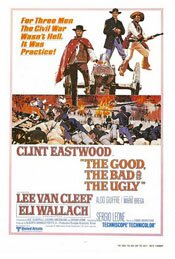 The Good, the Bad and the Ugly (1966)
The Good, the Bad and the Ugly (1966)
Directed by Sergio Leone
One of the best, and oddest, westerns ever made is The Good, the Bad and the Ugly (Il buono, il brutto, il cattivo). It’s hard to imagine anyone making a movie like this today. It’s too long (it would be argued). Some of the scenes, even shots, are too long. Gee, it takes 30 minutes to introduce the three primary characters. What’s that about?
Continue reading
The crazed and opulent Cleopatra
It’s appropriate that what I’ve written below about Cleopatra should be muddled as it is. That kind of reflects the movie. It’s a mess, in any number of ways, but what an arresting mess!
I’m pretty sure I saw this movie in the theatre when I was a kid and bits and pieces on TV over the years. I sat mesmerized through the entire movie about ten years ago when it came out on DVD. A week or so ago, however, I watched it again but this time it took me three days — I kept falling asleep on the couch. I suspect that was due to three things: 1) having seen it a few times already, 2) the sheer length of the movie and, 3) more wine than was wise.
As movies go, Cleopatra isn’t good or bad; it’s okay. But it’s probably the most fascinating “okay” movie you can see.
Continue reading
Characters in close quarters – Crimson Tide
You wouldn’t immediately associate submarine movies with a film like Key Largo but they have something in common. The dramatic tension comes about by having characters constrained within close quarters. In Key Largo, it’s within a hotel because of a hurricane; in submarine movies it’s due to the nature of submarines.
I don’t like a phrase like “submarine movies” but there is no getting around the fact there is a kind of sub-category of action-adventure films characterized by where they are set — on submarines. They’re often among the best of the action-adventure variety of films because of the close quarters that seem to force filmmakers to concentrate on characters.
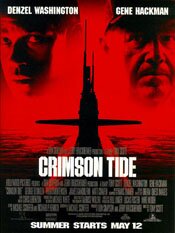 Crimson Tide (1995)
Crimson Tide (1995)
Directed by Tony Scott
In the tradition of movies like Run Silent, Run Deep, The Hunt for Red October and Das Boot, the Tony Scott directed Crimson Tide is submarine drama with strong lead characters. If it distinguishes itself from those previous movies it is by being faster moving and much noisier.
That may not sound overly appealing but it be would wrong to think that way. This is a very good, very engaging action-adventure with a strong foundation: the performances of Denzel Washington and Gene Hackman.
It’s also supported by strong performances by its supporting cast – Matt Craven, George Dzundza, Viggo Mortensen and James Gandolfini, to name a few.
Without its strong cast, I think this would likely be just an average film but with them it is firmly anchored.
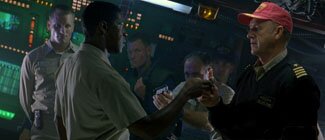
There is a state civil war in Russia. Rebel generals have taken over a base with nuclear weapons and it appears as if they may use them. The U.S. naval sub Alabama, nuclear-armed, is sent to Asian waters to await instructions. They get them: prepare your missiles. A further message, only partially received, may be orders to fire them or to stand down. It is unclear.
The movie’s conflict is between the sub’s captain (Gene Hackman) and its new executive officer (Denzel Washington). For the missiles to be fired, the two must be in agreement. They aren’t. The captain wants to fire; his second in command does not.

What makes movies like this dramatic and appealing (and you see this in films like Run Silent and Red October) is that the “bad guy” is external – off set. The leads, in this case Hackman and Washington, are both good guys but they are at opposing ends about what to do and thus in conflict.
This increases the film’s conflict by removing the easy, black and white choice and while an audiences’ sympathy may align with one, they can’t easily dismiss the other.
This is also reflected in the unfolding of the film’s drama where the sub’s crew must choose sides, many of whom are conflicted (like Mortensen’s Lt. Ince). We end up with struggles in the submarine, including mutiny, because of the lack of clarity. It’s all due to the ambiguity of the last orders received.
The movie doesn’t ease its audience into the story; it throws them in head first. Music and editing thrum as it begins with a journalist describing events in Russia. There is no slow unfolding of exposition. Director Scott and producer Jerry Bruckheimer take the approach of throwing the audience in at full speed. Details fly by like rapid fire flash cards.
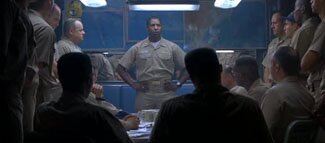
In some movies, this is noise and fury approach can be a gimmick to mask an uninspired story but in Crimson Tide it’s a quick and effective way to get quickly to what is an intelligent, well told story. Perhaps its due to the close quarters of submarines, but movies like this seem to lend themselves to dramatic, character-driven films.
While my own preference is for the quieter tension of a movie like The Hunt for Red October (which I find more effective), it works for Crimson Tide as it delivers a compelling film that leaves an audience with something to question and discuss when is over.
On the whole, this is a very good movie and well worth seeing and more than once.
John Ford, John Wayne and Expendable
Sometimes the release dates of movies can be significant. Get it wrong and you’re all in a muddle, as I was when I watched They Were Expendable.
The movie itself isn’t anything I would say you should rush out to see unless you’re a really big John Ford and/or John Wayne fan. The tone of it is curious, however, given the kind of movie it is and what it is about. Some movies are intriguing despite not being great films and that is the case with this one.
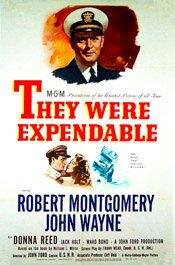 They Were Expendable (1945)
They Were Expendable (1945)
Directed by John Ford
I was very confused when I watched the war movie They Were Expendable because I thought it was from 1941. It turns out that is when the movie is set as it opens. My confusion evaporated, however, when I realized it was from 1945, though it is still an unusual movie that John Ford gives us.
Believe me, with this movie the year really matters – especially if you confuse it with four years earlier.
This movie was released in December of 1945. In World War II, Japan formally surrendered in September of 1945.
The movie is somber recounting of the early days of the war for the U.S., beginning with the attack on Pearl Harbor in December of 1941.
Made with the approval and assistance of the U.S. Navy, Army and Coast Guard, it shows us the U.S. getting its behind kicked by the Japanese – starting in Pearl Harbor and continuing through the Philippines.
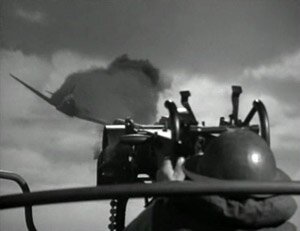
Audiences at the time of the film’s release, however, would be fully and completely aware of the end result of it all – victory in the Pacific; Japan’s surrender.
The reason John Ford shows us all the bad news from the war’s early days is because he’s telling the story of the PT boats – how their role in the war came about (they weren’t highly regarded originally), how they won respect and the sacrifices made by the crews that worked them. (The tagline was, “A tribute to those who did so much… with so little!”) However, the main character is really the boat itself.
The movie is a solemn tribute and sober homage but also full of patriotism which, appropriate to the period of its release, may strike a current day viewer as a bit much.
There are good action scenes in the movie as well as some interesting, almost noir-ish lighting in others. The movie itself appears to be in poor shape, at least on the DVD copy I have. I don’t know if any restorative work went into it but it doesn’t appear so given the scratches in a number of scenes. I’m a bit surprised it comes to use from Warner Brothers. It may have something to do with the lack of good original film materials. I don’t know.
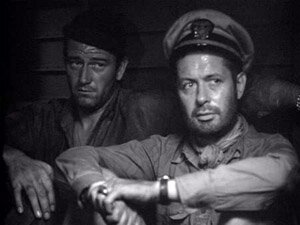
Overall, I can’t say this is a great movie. It’s a curious one, however. It’s worth seeing at least once, especially if you’re a fan of either John Ford or John Wayne. Just keep in mind this movie should probably be viewed as a propaganda work.
And maybe that is what makes it peculiar. It’s quite a bit of “Rah, rah!” about PT boats but seems to also want to be a solid drama and thus it acquires a bipolar quality.
A curious Long Goodbye from Robert Altman
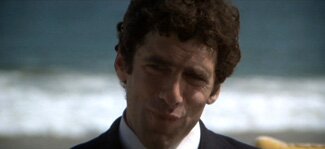
To be honest, I’ve never been a big Robert Altman fan, though increasingly I’m finding his movies more appealing. I think his approach creates the sense in me that I’m listening to a slow-talker and I want to interrupt and say, “Move it along; get to the point.” There’s an improvisational feel to character interaction and part of me want’s it more closely scripted and edited.
In The Long Goodbye this comes across partly because Altman gives his actors more responsibility to actually act, as he does with Elliott Gould here, and partly because the camera is constantly moving, as if you as a viewer are watching and trying to find a better vantage point. Some shots are through windows; some are even reflections in windows.
It’s intriguing, yet for me a bit irksome — but that’s just a personal, subjective thing. And what is odd about it is that I like this movie nonetheless.
 The Long Goodbye (1973)
The Long Goodbye (1973)
Directed by Robert Altman
Robert Altman’s The Long Goodbye is a bit like a fast food hamburger. It has beef in it but also has so many other things, and it has been altered to such a degree, that while it resembles a hamburger, it ain’t no hamburger.
In the same way, Altman’s movie is Raymond Chandler’s book, and resembles a film version of that book, but it ain’t Chandler’s book.
But then, you wouldn’t expect Altman to make a movie utterly faithful to its source.
Altman’s movie begins with the question, “What would happen if Marlowe, a character of the 40s and 50s, were to wake up and find himself in the early 70s?” In an interview, he says they referred to it as “Rip Van Marlowe” during the making of the movie. This idea dictates how the movie plays out.
Chandler’s Marlowe began in 1939 with The Big Sleep. His book The Long Goodbye was published in 1953. That is exactly twenty years before Altman’s The Long Goodbye.
Chandler’s Marlowe had been in about six books prior to the 1953 book. In The Long Goodbye, his Marlowe is older and mellower. The novel is a bit more reflective and, in my opinion, weighty. There is less emphasis on the tough guy posturing of the early books; he comes across as a more mature character. In some ways, there is a sense of alternating melancholy and apathy in him.
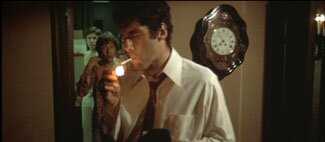
This may be what suggests the “Rip Van Marlowe” possibility to screenwriter Leigh Brackett and director Altman, or at least what makes this book a possible vehicle for working out that theme. However, there is more to the theme than just the “what if” aspect of a man from 1953 waking up in 1973. One thing that has changed for Marlowe is how people view friendship. The world has a different sense of ethics and morality and it isn’t in sync with his.
The movie opens with Philip Marlowe (Elliott Gould) literally waking up. The first half of the movie, particularly the first twenty minutes or so, give us such a slovenly, disconnected and half-asleep Marlowe that, the portrayal being so effective, he is incredibly annoying. He speaks under his breath, muttering to himself more than anyone else, even when responding to others around him. He’s almost completely unengaged with his world.
He shows no animation at all until his friend, Terry Lennox (Jim Bouton) shows up at his door. This is where the story’s engine turns over and it gets underway as Terry asks Marlowe to take him to Mexico.

The story makes some major turns from the Chandler book, some for the purposes of condensation and some … Perhaps because they didn’t want to make a movie faithful to its source but one that stood on its own legs as unique.
Having re-read the book recently (which is probably why I keep referring back to it), and it being my favourite of the Chandler novels, I can’t say I like the deviations. I found the book had more meaning for me than the movie largely because of those things that have been changed, though I do like the movie on its own merits.
But the book’s ending is much more effective and moving, I think. The movie is very direct – you can’t miss its point. In a way, it’s like Altman believes he has to be direct because people in 1973 are as much asleep as Marlowe was. His conclusion is like a bucket of cold water in the face.
The “asleep” idea recurs through the movie. It’s not just Marlowe who is somnambulant. His neighbours, the young women with their yoga and exercise, appear to be lost in their own world of new age exercise and spirituality. Roger Wade (Sterling Haydon) is lost in his alcohol and self-pity. Everyone is self-absorbed and inward looking and Marlowe is the one person who “wakened” to this contagion of social sleepwalking.
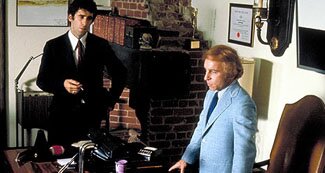
Marlowe “wakes up” because something has wakened him: the death of his friend Terry Lennox. He remains true to his friend, though for all intents and purposes it’s meaningless, isn’t it? (Terry is dead, after all.) Yet Marlowe won’t believe the murder and suicide that are being attributed to his friend.
No one else in the movie is true to anyone or anything. Even Marlowe’s cat abandons him when its favourite food is no longer there. Marty Augustine (Mark Rydell) speaks of how much he loves his girlfriend then strike her horribly for no reason. Roger Wade hits his wife when he is drunk.
Throughout the movie, as Marlowe makes his way, he sees a world of self-interest and no loyalty, making him an anachronism. When asked why he would try to clear the name of Terry Lennox, he hears variations of, “What’s it matter? He’s dead.”
The ending aside, this is probably the greatest deviation from the novel. In the book, respect and loyalty keep appearing – Marlowe is hired for his; the gangsters in the book (unlike the Marty Augustine character) respect Marlowe for his loyalty. Even some of the cops do. He is sought out and hired because it’s reported in the newspapers that he was picked up by the police for questioning and wouldn’t talk.
So the difference in the endings becomes a bit curious. Is it simply a more overt, can’t-miss-that meaning concerning betrayal of a friendship or is it also suggesting that Marlowe, too, is becoming part of that amoral culture of self-centeredness?
I’m not really sure. But I do know this is a curious movie Robert Altman has given us.


